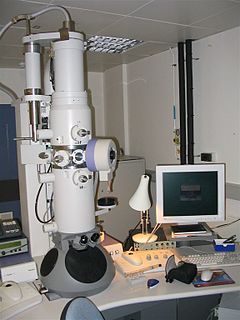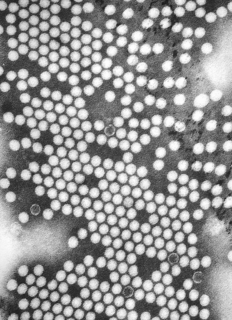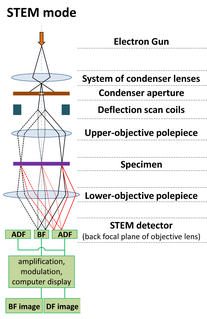Related Research Articles

An electron microscope is a microscope that uses a beam of accelerated electrons as a source of illumination. As the wavelength of an electron can be up to 100,000 times shorter than that of visible light photons, electron microscopes have a higher resolving power than light microscopes and can reveal the structure of smaller objects. A scanning transmission electron microscope has achieved better than 50 pm resolution in annular dark-field imaging mode and magnifications of up to about 10,000,000× whereas most light microscopes are limited by diffraction to about 200 nm resolution and useful magnifications below 2000×.

A microscope is an instrument used to see objects that are too small to be seen by the naked eye. Microscopy is the science of investigating small objects and structures using such an instrument. Microscopic means invisible to the eye unless aided by a microscope.

Transmission electron microscopy is a microscopy technique in which a beam of electrons is transmitted through a specimen to form an image. The specimen is most often an ultrathin section less than 100 nm thick or a suspension on a grid. An image is formed from the interaction of the electrons with the sample as the beam is transmitted through the specimen. The image is then magnified and focused onto an imaging device, such as a fluorescent screen, a layer of photographic film, or a sensor such as a scintillator attached to a charge-coupled device.

Thomas Eugene Everhart FREng is an American educator and physicist. His area of expertise is the physics of electron beams. Together with Richard F. M. Thornley he designed the Everhart-Thornley detector. These detectors are still in use in scanning electron microscopes, even though the first such detector was made available as early as 1956.

Alec Nigel Broers, Baron Broers, is a British electrical engineer.

A scanning transmission electron microscope (STEM) is a type of transmission electron microscope (TEM). Pronunciation is [stɛm] or [ɛsti:i:ɛm]. As with a conventional transmission electron microscope (CTEM), images are formed by electrons passing through a sufficiently thin specimen. However, unlike CTEM, in STEM the electron beam is focused to a fine spot which is then scanned over the sample in a raster illumination system constructed so that the sample is illuminated at each point with the beam parallel to the optical axis. The rastering of the beam across the sample makes STEM suitable for analytical techniques such as Z-contrast annular dark-field imaging, and spectroscopic mapping by energy dispersive X-ray (EDX) spectroscopy, or electron energy loss spectroscopy (EELS). These signals can be obtained simultaneously, allowing direct correlation of images and spectroscopic data.

Sir Charles William Oatley OBE, FRS FREng was Professor of Electrical Engineering, University of Cambridge, 1960–1971, and developer of one of the first commercial scanning electron microscopes. He was also a founder member of the Royal Academy of Engineering.

Daresbury Laboratory is a scientific research laboratory based at Sci-Tech Daresbury campus near Daresbury in Halton, Cheshire, England. The laboratory began operations in 1962 and was officially opened on 16 June 1967 as the Daresbury Nuclear Physics Laboratory by the then Prime Minister of United Kingdom, Harold Wilson. It is operated by the Science and Technology Facilities Council, part of UK Research and Innovation. It currently employs around 300 staff. The current director is Prof. Susan Smith.

The Department of Materials Science and Metallurgy (DMSM) is a large research and teaching division of the University of Cambridge. Since 2013 it has been located in West Cambridge., having previously occupied several buildings on the New Museums Site in the centre of Cambridge.

Nestor J. Zaluzec is an American scientist and inventor who works at Argonne National Laboratory. He invented and patented the Scanning Confocal Electron Microscope. and the π Steradian Transmission X-ray Detector for Electron-Optical Beam Lines and Microscopes.
Scanning confocal electron microscopy (SCEM) is an electron microscopy technique analogous to scanning confocal optical microscopy (SCOM). In this technique, the studied sample is illuminated by a focussed electron beam, as in other scanning microscopy techniques, such as scanning transmission electron microscopy or scanning electron microscopy. However, in SCEM, the collection optics is arranged symmetrically to the illumination optics to gather only the electrons that pass the beam focus. This results in superior depth resolution of the imaging. The technique is relatively new and is being actively developed.
Low-voltage electron microscope (LVEM) is an electron microscope which operates at accelerating voltages of a few kiloelectronvolts or less. Traditional electron microscopes use accelerating voltages in the range of 10-1000 keV.

Sir Colin John Humphreys, is a British physicist. He is the former Goldsmiths' Professor of Materials Science and a current Director of Research at the University of Cambridge, Professor of Experimental Physics at the Royal Institution in London and a Fellow of Selwyn College, Cambridge. He served as President of the Institute of Materials, Minerals and Mining in 2002 and 2003. His research interests include "all aspects of electron microscopy and analysis, semiconductors, ultra-high temperature aerospace materials and superconductors." Humphreys also "studies the Bible when not pursuing his day-job as a materials scientist."
Ondrej L. Krivanek FRS is a Czech/British physicist resident in the United States, and a leading developer of electron-optical instrumentation.
Brian Leonard Eyre CBE, FRS, FREng was a British material scientist, Chief Executive of the United Kingdom Atomic Energy Authority (UKAEA) and Professor at the University of Liverpool. He was also a visiting scholar at the University of Oxford and University College London.
Dame Pratibha Laxman Gai-Boyes is a British microscopist and Professor and Chair of Electron Microscopy and former Director at The York JEOL Nanocentre, Departments of Chemistry and Physics, University of York. She created the atomic-resolution environmental transmission electron microscope (ETEM) and is an outspoken advocate for women with careers in science.
In situ electron microscopy is an investigatory technique where an electron microscope is used to watch a sample's response to a stimulus in real time. Due to the nature of the high-energy beam of electrons used to image a sample in an electron microscope, microscopists have long observed that specimens are routinely changed or damaged by the electron beam. Starting in the 1960s, and using Transmission Electron Microscopes (TEMs), scientists made deliberate attempts to modify materials while the sample was in the specimen chamber, and to capture images through time of the induced damages.
Raymond Edward Smallman was a British metallurgist and academic known for his research into alloys and the causes of metal fatigue. Smallman was also a significant figure at the University of Birmingham, serving as its vice-principal between 1987 and 1992 and helping to establish its reputation as a leading modern research university.

Amanda Karen Petford-Long is a Professor of Materials Science and Distinguished Fellow at the Argonne National Laboratory. She is also a Professor of Materials Science at Northwestern University.

The Department of Materials is responsible for the teaching and research in materials science and engineering at Imperial College London, occupying the Royal School of Mines and Bessemer buildings on the South Kensington campus. It can trace its origins back to the metallurgy department of the Government School of Mines and Science applied to the Arts, founded in 1851.
References
- ↑ Goodhew, Peter. "Professor Peter J Goodhew FREng". pcwww.liv.ac.uk.
- ↑ Thin foil preparation for electron microscopy, P J Goodhew. 2nd edition North Holland, 1985 ISBN 0-444-80699-7
- ↑ Electron microscopy and analysis 3rd edition P J Goodhew, F J Humphreys and R Beanland, Taylor & Francis, 2001 ISBN 0-7484-0968-8
- ↑ Specimen Preparation for TEM of Materials, P J Goodhew, Royal Microscopical Society (Oxford U Press) 1984 ISBN 0-19-856403-1
- ↑ An Introduction to Scanning Transmission Electron Microscopy, R J Keyse, A J Garratt-Reed, P J Goodhew & G W Lorimer, 1998; BIOS ISBN 1-85996-066-9
- ↑ "No. 61803". The London Gazette (Supplement). 31 December 2016. p. N9.
- ↑ Teaching Engineering, P. J. Goodhew, 2010; UKCME ISBN 978-1-907207-22-8